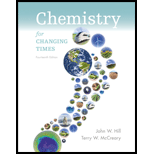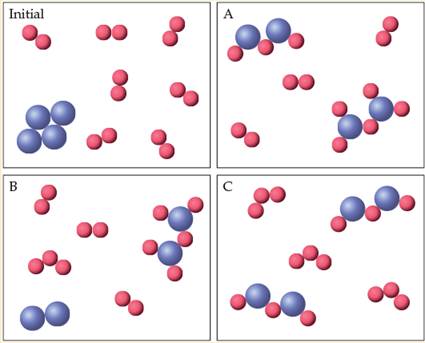
Chemistry for Changing Times
14th Edition
ISBN: 9780134212777
Author: John W. Hill; Terry W. McCreary
Publisher: Pearson Education (US)
expand_more
expand_more
format_list_bulleted
Concept explainers
Textbook Question
Chapter 2, Problem 11RQ
In the figure. the blue spheres represent phosphorus atoms, and the red ones represent oxygen atoms. The box labeled “lnitial represents a mixture. Which one of the other three boxes (A, B. or C) could not represent that mixture after a

Expert Solution & Answer
Want to see the full answer?
Check out a sample textbook solution
Students have asked these similar questions
Don't used Ai solution and don't used hand raiting
Don't used hand raiting and don't used Ai solution
2. Please fill in missing reactants, reagents, reaction conditions, or products in the
provided blank boxes
OMe
...-CF2-CF2-CF2-CF2-CF2-...
Chapter 2 Solutions
Chemistry for Changing Times
Ch. 2 - Prob. 1RQCh. 2 - Prob. 2RQCh. 2 - Prob. 3RQCh. 2 - Prob. 4RQCh. 2 - Cavendish found that water was composed of two...Ch. 2 - Prob. 6RQCh. 2 - Fructose (fruit sugar) is always composed of 40,0%...Ch. 2 - Outline the main points of Dalton's atomic theory,...Ch. 2 - Prob. 9RQCh. 2 - Prob. 10RQ
Ch. 2 - In the figure. the blue spheres represent...Ch. 2 - 12. a. How is Avogadro’s number linked with the...Ch. 2 - Prob. 13RQCh. 2 - Prob. 14RQCh. 2 - Prob. 15PCh. 2 - 16. An iron nail dissolves in a solution of...Ch. 2 - If you place a 400 g effervescent antacid pill...Ch. 2 - Prob. 18PCh. 2 - 19, Acetylene, used for welding, contains 24.02 g...Ch. 2 - 20. Nitrous oxide (N2O, "laughing gas") contains...Ch. 2 - Prob. 21PCh. 2 - Prob. 22PCh. 2 - Prob. 23PCh. 2 - Prob. 24PCh. 2 - When 18.029 of water is decomposed by...Ch. 2 - Prob. 26PCh. 2 - Prob. 27PCh. 2 - Prob. 28PCh. 2 - Prob. 29PCh. 2 - Prob. 30PCh. 2 - 31. Use Dalton's atomic theory to explain what is...Ch. 2 - Prob. 32PCh. 2 - Hydrogen and oxygen combine in a mass ratio of...Ch. 2 - Prob. 34PCh. 2 - Prob. 35PCh. 2 - A compound containing only oxygen and rubidium has...Ch. 2 - 37. A sample of an oxide of tin with the formula...Ch. 2 - 38. Consider three oxides of nitrogen, X, Y, and...Ch. 2 - Prob. 39PCh. 2 - Prob. 40PCh. 2 - Prob. 41PCh. 2 - Prob. 42PCh. 2 - Prob. 43PCh. 2 - Prob. 44PCh. 2 - A blue solid called azulene is thought to be a...Ch. 2 - Prob. 46PCh. 2 - Prob. 47APCh. 2 - Prob. 48APCh. 2 - Prob. 49APCh. 2 - Prob. 50APCh. 2 - 51. See Table 2.1 . Another compound of nitrogen...Ch. 2 - Prob. 52APCh. 2 - Prob. 53APCh. 2 - Prob. 54APCh. 2 - Prob. 55APCh. 2 - Prob. 56APCh. 2 - Prob. 57APCh. 2 - Prob. 58APCh. 2 - Prob. 2.1CTECh. 2 - When water is electrolyzed, from each one molecule...Ch. 2 - A health-food store has a large display of...Ch. 2 - Prob. 2.4CTECh. 2 - Prob. 2.5CTECh. 2 - Prob. 2.6CTECh. 2 - Prob. 1CGPCh. 2 - Prob. 2CGPCh. 2 - Prob. 3CGPCh. 2 - Prob. 4CGPCh. 2 - Prob. 5CGPCh. 2 - Materials Needed: Alka-Seltzer tablets (8) 1/4 cup...Ch. 2 - Materials Needed: Alka-Seltzer tablets (8) 1/4 cup...Ch. 2 - Prob. 3CHQ
Knowledge Booster
Learn more about
Need a deep-dive on the concept behind this application? Look no further. Learn more about this topic, chemistry and related others by exploring similar questions and additional content below.Similar questions
- X Draw the major products of the elimination reaction below. If elimination would not occur at a significant rate, check the box under the drawing area instead. ది www. Cl + OH Elimination will not occur at a significant rate. Click and drag to start drawing a structure.arrow_forwardNonearrow_forward1A H 2A Li Be Use the References to access important values if needed for this question. 8A 3A 4A 5A 6A 7A He B C N O F Ne Na Mg 3B 4B 5B 6B 7B 8B-1B 2B Al Si P 1B 2B Al Si P S Cl Ar K Ca Sc Ti V Cr Mn Fe Co Ni Cu Zn Ga Ge As Se Br Kr Rb Sr Y Zr Nb Mo Tc Ru Rh Pd Ag Cd In Sn Sb Te I Xe * Cs Ba La Hf Ta W Re Os Ir Pt Au Hg Tl Pb Bi Po At Rn Fr Ra Ac Rf Ha ****** Ce Pr Nd Pm Sm Eu Gd Tb Dy Ho Er Tm Yb Lu Th Pa U Np Pu Am Cm Bk Cf Es Fm Md No Lr Analyze the following reaction by looking at the electron configurations given below each box. Put a number and a symbol in each box to show the number and kind of the corresponding atom or ion. Use the smallest integers possible. cation anion + + Shell 1: 2 Shell 2: 8 Shell 3: 1 Shell 1 : 2 Shell 2 : 6 Shell 1 : 2 Shell 2: 8 Shell 1: 2 Shell 2: 8arrow_forward
- Nonearrow_forwardIV. Show the detailed synthesis strategy for the following compounds. a. CH3CH2CH2CH2Br CH3CH2CCH2CH2CH3arrow_forwardDo the electrons on the OH participate in resonance with the ring through a p orbital? How many pi electrons are in the ring, 4 (from the two double bonds) or 6 (including the electrons on the O)?arrow_forward
arrow_back_ios
SEE MORE QUESTIONS
arrow_forward_ios
Recommended textbooks for you
 Living By Chemistry: First Edition TextbookChemistryISBN:9781559539418Author:Angelica StacyPublisher:MAC HIGHER
Living By Chemistry: First Edition TextbookChemistryISBN:9781559539418Author:Angelica StacyPublisher:MAC HIGHER Chemistry & Chemical ReactivityChemistryISBN:9781337399074Author:John C. Kotz, Paul M. Treichel, John Townsend, David TreichelPublisher:Cengage Learning
Chemistry & Chemical ReactivityChemistryISBN:9781337399074Author:John C. Kotz, Paul M. Treichel, John Townsend, David TreichelPublisher:Cengage Learning Chemistry & Chemical ReactivityChemistryISBN:9781133949640Author:John C. Kotz, Paul M. Treichel, John Townsend, David TreichelPublisher:Cengage Learning
Chemistry & Chemical ReactivityChemistryISBN:9781133949640Author:John C. Kotz, Paul M. Treichel, John Townsend, David TreichelPublisher:Cengage Learning ChemistryChemistryISBN:9781305957404Author:Steven S. Zumdahl, Susan A. Zumdahl, Donald J. DeCostePublisher:Cengage Learning
ChemistryChemistryISBN:9781305957404Author:Steven S. Zumdahl, Susan A. Zumdahl, Donald J. DeCostePublisher:Cengage Learning
 Chemistry: An Atoms First ApproachChemistryISBN:9781305079243Author:Steven S. Zumdahl, Susan A. ZumdahlPublisher:Cengage Learning
Chemistry: An Atoms First ApproachChemistryISBN:9781305079243Author:Steven S. Zumdahl, Susan A. ZumdahlPublisher:Cengage Learning

Living By Chemistry: First Edition Textbook
Chemistry
ISBN:9781559539418
Author:Angelica Stacy
Publisher:MAC HIGHER

Chemistry & Chemical Reactivity
Chemistry
ISBN:9781337399074
Author:John C. Kotz, Paul M. Treichel, John Townsend, David Treichel
Publisher:Cengage Learning

Chemistry & Chemical Reactivity
Chemistry
ISBN:9781133949640
Author:John C. Kotz, Paul M. Treichel, John Townsend, David Treichel
Publisher:Cengage Learning

Chemistry
Chemistry
ISBN:9781305957404
Author:Steven S. Zumdahl, Susan A. Zumdahl, Donald J. DeCoste
Publisher:Cengage Learning


Chemistry: An Atoms First Approach
Chemistry
ISBN:9781305079243
Author:Steven S. Zumdahl, Susan A. Zumdahl
Publisher:Cengage Learning
Atomic Number, Atomic Mass, and the Atomic Structure | How to Pass ChemistryThe Nucleus: Crash Course Chemistry #1; Author: Crash Course;https://www.youtube.com/watch?v=FSyAehMdpyI;License: Standard YouTube License, CC-BY